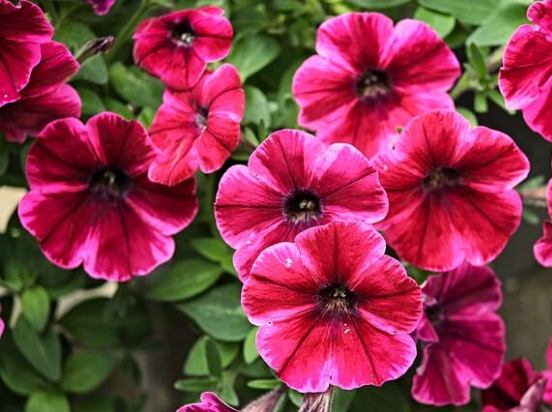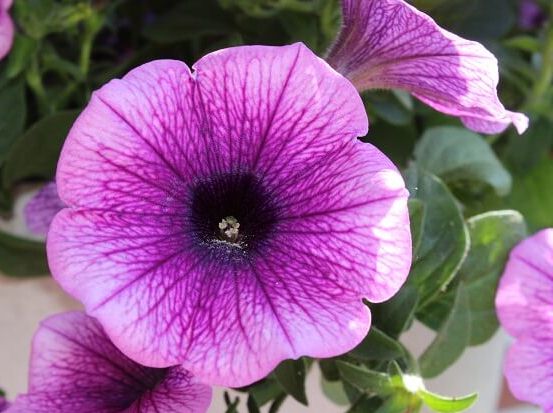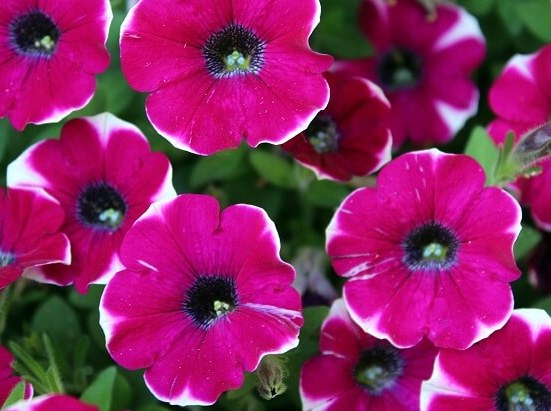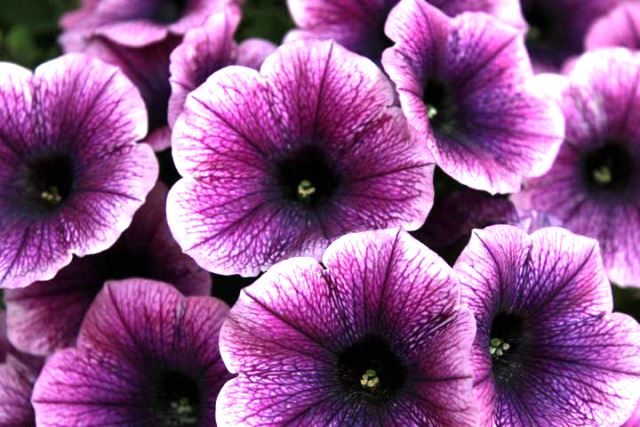Terms and rules for planting seedlings in open ground
Every florist is looking forward to the desired moment for any gardener - an open ground transplant. But when to transplant petunia seedlings? The best time to plant plants is from the second half of May to mid-June.
It is very important to harden it before transplanting seedlings. For hardening, the seedlings should be taken out into the open air, gradually increasing the time spent outdoors (starting in a short time interval)
When transplanting petunia seedlings into open ground in a flower bed, you should adhere to the following scheme:
- First of all, you should choose a place. For planting in open ground, it is necessary to choose a site that is well lit, has fertile soil (preferably loamy). If the soil is not fertile, then it is advisable to apply fertilizer.
- Then you should water the plants abundantly and plant petunia seedlings in the holes using the transshipment method.
- Landing should be carried out taking into account the optimal distance. When planting, it is necessary to take into account the distance between the seedlings - about 20 to 30 centimeters. The depth of the planting hole should be at least ten centimeters.
- It is recommended to protect young plants in the flowerbed with mulching material (peat, humus).
If you have seedlings of an ampelous variety and you plan to transplant it into a pots, pot or other any other container, then you should know some features:
Choose a large container that has drainage holes.
It is recommended to pour drainage material about three centimeters thick at the bottom of the pot or planter.
The potting soil can be used the same as for growing seedlings.
It is also necessary to transplant in a transshipment way, without breaking an earthen coma with rhizomes
The plant should be transferred carefully so as not to damage the roots .. Video: how to properly transplant seedlings into a pot.
Video: how to properly transplant seedlings into a pot.
Now you have learned all the subtleties and secrets of how to grow petunia seedlings at home. At first glance, it may seem that the growing process is too complicated, requires a lot of resources and it is easier to buy ready-made seedlings on the market or in specialized stores. But in reality, everything is not so difficult! With the correct implementation of all stages, following the step-by-step instructions, rules and tips, you can easily grow and get strong, healthy and good seedlings that will look stylish, delight you with beautiful, lush color in the garden of your house, cottage, in pots, pots.
When to plant petunia seedlings outdoors?
Planting petunias in open ground is carried out using a special technology.
First, the seedlings are watered abundantly with water at room temperature to soften the earth. This will avoid injury to the root system of plants, as it is very fragile.
Seedling planting scheme:
- upright varieties with large flowers - 25x25 cm;
- varieties with small flowers - 15x15 cm;
- in boxes on the balcony - 12x15 cm.
After transplanting, the seedlings are watered abundantly, the soil is mulched with peat, and after 2 weeks fertilizers are applied.
- During the growing season, plants carry out the following work:
- Regular watering.
- Removal of dry flowers.
- Pinching of long shoots.
- Fertilization.
- Weed control in the flower bed.
As you can see planting petunias with seeds for seedlings at home is not so difficult and even a novice gardener can do it. The main thing is to do everything according to the rules described in this article, and you can enjoy the beautiful flowering of petunias all summer long.
Tricks of sowing petunia seeds
Sowing begins with the need to select seed. For growing on a balcony fence and in a suspended form, plants with long lashes are usually purchased, compact plants are planted in flower beds. The most important thing is not to buy plant seeds that reproduce vegetatively, that is, by cuttings. These include surfinia, in another way they are called supertunia.
Under the guise of this flower, they can offer ampelous petunia. Seeds of unique species cannot be cheap and they are not packaged in 50 pieces in one pack, such seeds are packed individually.
Seeds can be purchased only after checking the presence of marking with information about the end of their use. The package must have a barcode, the name of the manufacturer, there must be a characteristic of the plant with recommendations for growing and information that the seeds have been tested for germination.
Dragee seeds are highly germinating; they are usually packed in a plastic or glass flask before being placed in a paper bag.
Before sowing seeds, you need to decide on the place where the seedlings will be grown, prepare the soil and planting containers with holes for draining the water. The soil must be shed with water two days before sowing so that on the day of sowing it is moist, but not wet.
The containers are chosen taking into account whether the seedlings will be dived, or the plant has decided not to dive. Seedlings are grown in a warm, well-lit place with devices for additional lighting and heating. In addition, it should be possible to reduce the temperature around the seedlings if necessary.
To stop pulling seedlings at night, the ambient temperature is reduced by 3-5 ° C.
Why petunia seedlings fall and die
Flowers are very delicate creatures. And it's not easy to grow them. At every step, the seedlings are trapped in trouble, which can affect the health of young shoots.
The reasons why the seedlings fall and die:
- The first difficulties appear with seedlings. Or rather, with the fact that there are no seedlings at all or they are very bad. This can happen due to the strong burial of seeds in the ground during sowing. It is known that the seeds of petunias are very small and therefore very weak. They simply cannot get through the soil layer. Therefore, the seeds of petunia are not covered with earth, but simply laid out on the surface of the soil and lightly watered so that they "drown" to the required depth.
- Poor seed quality. This is one of the reasons for the "non-emergence" of seeds, in which the gardener is not to blame. The seeds can be old or rotten and therefore have no vitality.
- Seedlings do not throw off the shell and die. It so happens that the shoots are too weak and cannot throw off the shell on their own, which subsequently becomes the cause of the death of the seedlings. Perhaps this is due to the fact that the seeds are bad or in the box under the film is too dry. If it becomes obvious that the seedlings have such a problem, then the humidity of the environment should be increased. The frequency of airing is reduced. You can even help the shoots to throw off the shell: for this, the shoots must be moistened with water, pry off the film with a needle and remove it yourself.
- Defeat by disease. It so happens that suddenly the seedlings begin to fall and quickly die. The reason for this may be a disease called "black leg". If the stem has darkened at the base, this means that the plants have been attacked by fungus from the soil. The disease occurs with excessive soil moisture and lack of ventilation. In such a highly humid and warm environment, the fungus develops rapidly. And if you miss the onset of the disease, then in a few days the disease will spread to all plantings. Unfortunately, diseased plants cannot be saved - they will have to be thrown away as soon as possible. Healthy seedlings need to be cut into new soil.Weak hilling of the earth under the shoot can save from the fungus, watering in such a way that the earth next to the stem remains dry.
Adult seedlings are affected by the black leg due to weakened immunity. To increase the vitality of petunias every ten days they are treated with nitrophos, "Kemira" or "Solution".
Please note: too acidic soil can also lead to blackening of the stems. If so, you need to change the soil to a more neutral one as soon as possible.
That primer is suitable if the litmus paper is colored red-violet.
Sometimes the seedlings fall, as they grow in unfavorable conditions. Or rather, too little sunlight falls on it, and the temperature in the room is too high. As a result, the stems are excessively stretched, while they are very frail, and therefore begin to fall to the sides. If you do not take action, then the seedlings will not give the necessary number of branches for lush flowering. Therefore, if there is not enough light, then you need to supplement the petunias with artificial light.
It is also possible that the seedlings are growing too densely and those plants that are in the thickets do not receive much light. In this case, the flowers should be thinned out.
Pulling seedlings is also possible due to the dry indoor air. This often happens in winter when the heating is on. To avoid overgrowth of seedlings, boxes with petunias are lowered to the floor or the temperature in the room is lowered.
Pinching will help to slow down the rapid growth of stems up. Then the growth of lateral branches is activated.
- if there is little nitrogen, the leaves are small and yellow;
- with a lack of phosphorus, the color of the leaves becomes blue-violet;
- if the lower leaves turn yellow, there is too much nitrogen;
- if the upper leaves turn yellow and turn white, the plant lacks iron.
All this can be avoided if complex mineral dressings are applied on time. And if the seedlings are attacked by harmful insects, then getting rid of them is possible only by treating the bushes with insecticidal agents.
The seedlings stop growing. It is often possible to observe a situation when the seedlings suddenly stop growing and then die. This is due to the small amount of soil in the seedling tank. The roots simply have nowhere to develop, and plant growth stops accordingly. To solve the problem is quite simple - you need to transplant the seedlings into a larger container.
Growing healthy petunia seedlings is not an easy task. There are a lot of reasons why you can ruin young flowers. But they all mainly come from the gardener's ignorance of the rules of agricultural technology.
All mistakes can be corrected only by following all the recommendations, and enveloping the flowers with your attention and daily care
Flower care
- After planting the plants for several weeks, it is necessary to water the area regularly every 2-3 days. After the first shoots appear, the regularity of watering decreases to once every 5 days.
- After the first shoots appear, fertilizer should be applied. The most commonly used potassium, which is introduced into the soil during irrigation.
- After the formation of seedlings, it is necessary to regularly remove weeds and fluff the ground. This is necessary so that the roots can be saturated with the required amount of oxygen.
- Before starting the formation of inflorescences, it is necessary to add organic substances, for example, an infusion of chicken droppings or manure. Such feeding increases the flowering period and promotes the appearance of immunity.
- Faded buds must be cut off; to collect seeds, it is necessary to leave several large buds, which are cut off after the seeds have formed or left on the bushes so that the seeds can get into the ground on their own.
- If the plant keeps roots in the ground, they should be covered with spruce branches in late autumn. The insulation is removed in mid-April.
Ornamental crops, which are planted in the soil with the help of seeds, allow you to maintain all maternal qualities and tend to germinate quickly
After harvesting the seeds, it is important to store them properly. Seeds must be dry and stored in a cloth bag
Properly preserved flower seeds germinate quickly even without prior germination. Flowers can be planted in spring or summer, depending on the variety and ripening period.
Before starting planting, it is important to properly prepare the soil and add all the necessary nutrients.
4.Petunia - planting and care
4.1 Growing outdoors
Petunias are planted on the street using seedlings - in the second half of May, when the threat of return spring frosts has passed.
Before planting, the seedlings must be hardened - they are accustomed to new conditions of existence, taking containers with flowers outside in the daytime. Gradually, the time spent in the fresh air is increased.
A well-lit place is prepared for planting - they dig up the soil and remove weeds. When grown in partial shade, flowering will be less abundant. The site must be protected from strong gusts of wind that can damage the delicate shoots of the flower. Wetlands are not suitable for growing petunias.
Soils poor in nutrients are ennobled by the addition of humus and leaf humus. To loosen and improve drainage, coarse river sand is mixed into the ground.

Planting holes are prepared, keeping a distance between them, depending on the planting scheme and plant variety - about 30 - 40 cm.
You should not choose a sunny and hot day for planting - plants will better acclimate in cloudy and warm weather.
Before planting, the bushes are thoroughly watered with warm water so that the soil becomes soft and easier to move away from the walls of the cups.
Plants are moved by the transfer method - if possible, keeping a whole clod of earth at the root system. Flowers transplanted in this way will move faster and bloom faster.
Plants are placed at the bottom of the planting holes and sprinkled with earth in a circle, tamping it slightly to remove air pockets. After transplanting, the flowers are watered with plenty of water.

To curb the growth of weeds, the bases of the plants are mulched with sawdust or straw.
In the first month after planting, small bushes should be regularly watered; in the future, the plants will tolerate short dry periods.
Since petunia blooms very abundantly and for a long time, it will need timely feeding to maintain health and abundant bud formation. They begin to feed the flowers a week after planting with fertilizers high in potassium and phosphorus. Top dressing with mineral fertilizers is carried out every decade, introducing a nutrient solution into wet soil.

In order for air to reach the plant roots, the soil under the bushes is loosened to a shallow depth.
4.2 Wintering petunias
Petunia does not tolerate wintering in the open ground and in the autumn months it is transplanted into pots, almost all the green mass is cut off, leaving stalks about 12-15 cm long and moved to a room with a temperature of 12-14 ° C.

4.3 When it blooms
Petunia is one of the longest and most abundant flowering plants. It blooms with large, funnel-shaped flowers from spring, all summer until late autumn.
When grown outdoors, flowering is often interrupted only by the onset of frost.
How to properly grow petunia seedlings
Petunia can be grown in three ways: at home on a windowsill, in a greenhouse, or in an open greenhouse. If you choose for yourself the option of planting petunias at home, then seeds can be planted from late winter or early spring. If you are planting petunia in a greenhouse or greenhouse, then this can only be done from the first spring months. The soil "adored" by petunia is a mixture of river sand, coconut fiber and vermicompost. The aspect ratio should be 1: 2: 3. The sand must be taken clean, if there is silt or other impurities in it, they must be washed, and the sand must be dried.

When planting seeds, they should not be planted deeply, they should be on the surface and only slightly sprinkled with soil, lightly pressed with fingertips. The sand must be saturated with water before planting the seeds in the general soil mixture, this will allow more shoots to be obtained. After planting the seeds, create a greenhouse effect for them; this can be done with glass or transparent film. For effective germination of seeds, high humidity is required, if you adhere to it, then in a week you can see the first shoots. Keep an eye on the temperature of the room where the seeds are sown. The optimum temperature for the development of sprouts is 25 degrees Celsius. After you see the first shoots, it is necessary to ventilate and remove the glass or film for a certain time. So, on the first day of airing the sprouts, it is necessary to remove the covering material for half an hour, on the second day for one and a half to two hours, on the third day keep the sprouts without shelter for up to 4 hours. Starting from the seventh day, the covering material can be completely abandoned.
Do not be afraid that in the first month your petunia will grow very little, because at this time the main development and growth are assigned to the root of the plant. When the root gains its strength, then the ground part will receive its growth. When the 36th day of planting the seeds comes, you should pick the plant. For petunias, it is not a problem to calmly transfer the pick and take root in a new place. On the first day after transplanting, the petunia should be well watered, further watering should be moderate and carried out as the upper soil crust dries.
Petunia loves the sun, so it should be placed in a well-lit area. With the onset of solid heat in May, petunia can be planted in open soil. But it is necessary to take into account the climatic zone of residence so that during planting of seedlings in open ground it is warm enough, because petunia does not tolerate cold.
How to grow petunia seedlings from seeds
Soil for seedlings of petunias
Petunia seedlings are grown in neutral or slightly acidic soil - it is desirable that it be a loose nutrient mixture that can retain moisture, but not block. In flower shops, you can buy a ready-made soil mixture, for example, the universal substrate Stender, but in 5 liters of such a mixture you need to add a half-liter can of wood ash, 250 g of perlite, a tablespoon of potassium sulfate or the same amount of Kemira and mix everything well.
You can prepare the soil by mixing two parts of sod land, humus and well-decomposed peat with one part of sand. Or make soil from garden soil, sand and peat in a 1: 1: 2 ratio. After you mix the ingredients thoroughly, sift the soil twice through a sieve: the first time through a large sieve, the second time through a smaller sieve. Then the soil composition is spilled with a strong solution of potassium permanganate or Previkur's solution, prepared in accordance with the instructions.
Sowing petunias for seedlings at home
As for petunia seeds, you need to buy them from reliable producers, otherwise you may have difficulties with their germination. It is not necessary to subject the pelleted seeds to pre-sowing preparation, but it should be borne in mind that in dry soil they do not germinate well due to the fact that their shell does not dissolve. If you are purchasing regular seeds, be sure to find out the conditions and terms of their storage. The seeds must be fresh, as poor seed germination is the main problem with growing petunia seedlings.
How to plant petunias for seedlings? At the bottom of a container treated with a solution of potassium permanganate, and then a container washed with clean water (it can be a wooden or plastic box with a height of at least 10 cm with drainage holes), place fine expanded clay, and on top of it lay a disinfected soil mixture in such an amount that from the surface of the soil to the edge of the dishes 2 cm remained.If there is snow in the yard, lay it on the ground and tamp it lightly - petunia seeds are best sown in the snow. Spread the seeds on top of the snow layer and cover the container with plastic wrap or glass. When the snow melts, the seeds will be sucked into the ground.
To evenly distribute small petunia seeds over the surface of the soil, it is better to pre-mix them with sand.
If there is no snow, then the seeds are laid out on moistened soil, and then they are lightly sprayed from a fine spray bottle and covered with a transparent material that does not allow air to pass through. Do not cover seeds - petunia will only germinate in light. Keep crops in a well-lit place at a temperature of 25 ºC.
How to grow petunia seedlings in tablets
It is better to sow pelleted seeds in peat tablets. Petunia seedlings are grown in peat tablets of medium size - with a diameter of 3.5 or 4.5 cm.The tablets are soaked in water to swell, then the excess water is drained, tablets are made into a high tray, one seed is placed in each tablet with a match or toothpick, and then Pour water over each seed with a pipette - the seed coat should get wet
After 3-5 minutes, gently spread the loosened shells to make it easier for the seeds to germinate, cover the tray with a transparent lid and place the crops in the brightest place where the air temperature is kept within 25 ºC
Growing petunia seedlings in tablets contributes to better seed germination and greatly facilitates the care of seedlings, since it eliminates the need to pick them, injuring the root system. And by the way, it is easy to determine by the color of the tablets whether the seedlings need watering.
Growing seedlings of petunias in cassettes
The most convenient containers for growing petunias are cassettes with cells - they can be used repeatedly, they save space and avoid picking seedlings. Now on sale you can find cassettes with different numbers of cells, and the more cells in the cassette, the smaller they are in size.
For petunia seedlings, it is better to use cassettes with large cells. The height of the cells must be at least 10 cm.
As a soil, you can use all those soil mixtures that we have already described in, or you can grow petunia seedlings in tablets by placing them in a swollen form in the cells of the cassette. Otherwise, sowing seeds and growing seedlings in cassettes are carried out as usual.


